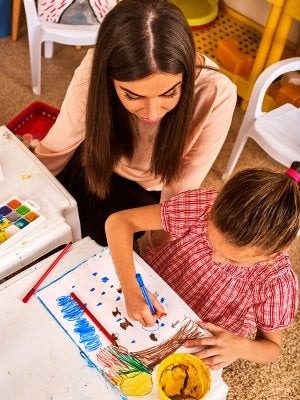-
Your Child’s Curiosity-Driven Education
From “Why is the sky blue?” to “How do black holes work?” your child’s curiosity over the years will drive his or her education. Humans are innately curious, and it’s this trait that propels them to achieve remarkable accomplishments. Even before your child can speak, he or she curiously explores the surrounding world by touching, tasting, and dropping objects over and over again. It’s why early childhood learning centers in Pembroke Pines give young children the freedom to explore the classroom. By nurturing your child’s curiosity from his or her early education to adulthood, you’re encouraging the love of learning.
The Value of Curiosity
Few people learn effectively by listening to boring, unengaging lectures. From the 1950s onward, researchers studying the science of learning have found that people learn best when their curiosity is piqued. In other words, curiosity directly fuels academic achievement. But curiosity can also be stifled inadvertently, such as when adults discourage children from asking questions. Since curiosity substantially influences early education, it’s important to nurture it.http://www.ascd.org/publications/educational-leadership/feb13/vol70/num05/the-case-for-curiosity/

An Easy Way to Redirect Creative Energy
Of course, a child’s curiosity can often get him or her into trouble. Finding out how the plumbing works by flushing a toothbrush isn’t a welcome turn of events. You can have the best of both worlds by validating your child’s curiosity and redirecting it to less problematic actions. For instance, if your child wants to know what would happen if he or she dropped an egg on the floor, you could invite him or her to take an egg outdoors and drop it on the ground instead. If your child asks you why walruses have tusks, you could say, “I’m not sure. Let’s look it up and find out!”
The Building of Connections Through Curiosity
You are your child’s first role model, and one of the most valuable lessons you can teach your child is that admitting a lack of knowledge is the first step toward learning. Parents often try to avoid saying, “I don’t know” to their kids. This is understandable, but it also suppresses curiosity. Instead, you can teach your child that it’s okay not to know everything—and that’s why people ask others for information or help. If your child is curious about life on a farm, take him or her to a working farm for a tour, or set up some face time with a relative who milked cows.
-
Help Your Child Create an Illustrated Book
Early education activities are often fun for adults as well as children, as they are typically hands-on, creative exercises. At this young age, children learn best by manipulating physical objects and stimulating the senses. For example, you can help your pre-k student in Pembroke Pines create his or her own illustrated book. For this pre-kindergarten activity, you’ll need about five to 10 sheets of blank paper or colored construction paper. Assemble some assorted markers or crayons, or let your child use finger paints or watercolors.
Ask your child to tell you a story. It could be a list of fun things your child did that day, or what the two of you saw during a walk in the park. If your child was at the early childhood education center, the story could be about what he or she did in the classroom. Write down your child’s story, using a new sheet of paper for each main point. Invite your child to illustrate the pages, and then staple them together. Don’t forget the cover page!

-
See How One Classroom Learns About Empathy
See How One Classroom Learns About Empathy
Your child’s education is a priceless investment in his or her future. Kindergarten schools in Pembroke Pines can help build character and cultivate empathy, while also teaching the basics like kindergarten math. Empathy is intuitive, but it’s also a skill that can be taught. You can see how one classroom in Boston cultivates empathy when you watch this video.
You’ll hear from the kindergarten teacher and a few of her students as they complete an activity called “A Mile in Someone Else’s Moccasins.” Since kids this young have a hard time grasping abstract concepts, this activity is a more direct, concrete way of teaching students to be mindful and respectful of other people’s feelings and perspectives.
-
Here’s Why Fingerplays Benefit Preschoolers
Sometimes, low-tech solutions are best when it comes to activities for preschoolers. Long before young children attended learning centers and worked their way through a preschool curriculum , mothers used lullabies, rhymes, and fingerplays to soothe and engage them. These simple activities are still a staple in preschools in Pembroke Pines, as they offer a wide range of benefits for young learners.

Communication
One of a preschool teacher’s jobs is to help children fine-tune their communication skills, language comprehension, and vocabulary. Fingerplays fit all of these requirements. These simple activities capture the children’s attention, and encourage them to focus on what the teacher is saying or singing. Children practice following directions by copying the teacher’s movements, and singing along. And since fingerplays can involve a wide range of topics, they’re an effective tool for reinforcing vocabulary words.
Engagement
Early childhood education research reveals that engaging a child’s senses is a pathway to learning. Fingerplays do much more than just capture an active child’s attention. They stimulate his or her auditory, visual, and tactile senses. Fingerplays are also a form of kinesthetic learning, as the students are encouraged to enjoy movement while participating in them.
Imagination
Many preschool activities involve manipulating physical learning materials. Fingerplays are hands-on too, but in a different way. They encourage children to use their imagination to visualize the story expressed in the rhyme or song. For instance, the accompanying fingerplay to the Itsy Bitsy Spider rhyme uses innovative movements to mimic a spider climbing up the waterspout, and then being washed away by the rain.
Motor Skills
At such a young age, children must work hard to master their fine motor skills. Even before they master the act of gripping a pencil, kids can build muscle strength in their hands and fingers, and hand-eye coordination by mimicking fingerplays. Some fingerplays also engage gross motor skills, such as by reaching the arms up over the head.
Examples
Consider learning some of the fingerplays your child is doing in school. One common example is the apple tree fingerplay. Here are the rhymes and their accompanying movements:
- Way up high in the apple tree (Point upward)
- Five red apples looked at me (Show five fingers)
- I shook that tree as hard as I could (Use both hands, pretend to shake a tree)
- Down came an apple (Wiggle fingers while moving the hands downward)
- Mmm, it was good (Rub your stomach)
You can then repeat the fingerplay with four, three, two, and one apple to start with.
RECENT POSTS
categories
- Uncategorized
- Early Learning Center
- Pre-K
- Children
- Child Care Center
- Preschooler
- Preschool Blog Category | Tanglewood Academy
- Preschool Lunch
- Tanglewood Academy
- After-School Program
- Toddler School
- Early Childhood Education
- preschool activities
- pre-kindergarten
- childhood education
- pre-kindergarten programs
- Children’s education
- enrichment opportunities
- Kindergarten
- Nurturing Education Environment
- Toddler Care
- Child Separation Anxiety
- Toddlers
- Summer camp
- summer activities
- VPK
- Voluntary Pre-K
- Outdoor Activities
- Smart Strategies
- Tie Shoes
- Snacks
- Physical Activities
- Education
- Enrichment Activities for Kids
- Early Education Activities
- Preschool Curriculum
- Classroom Learning
- APPLE accreditation
- Language Comprehension
